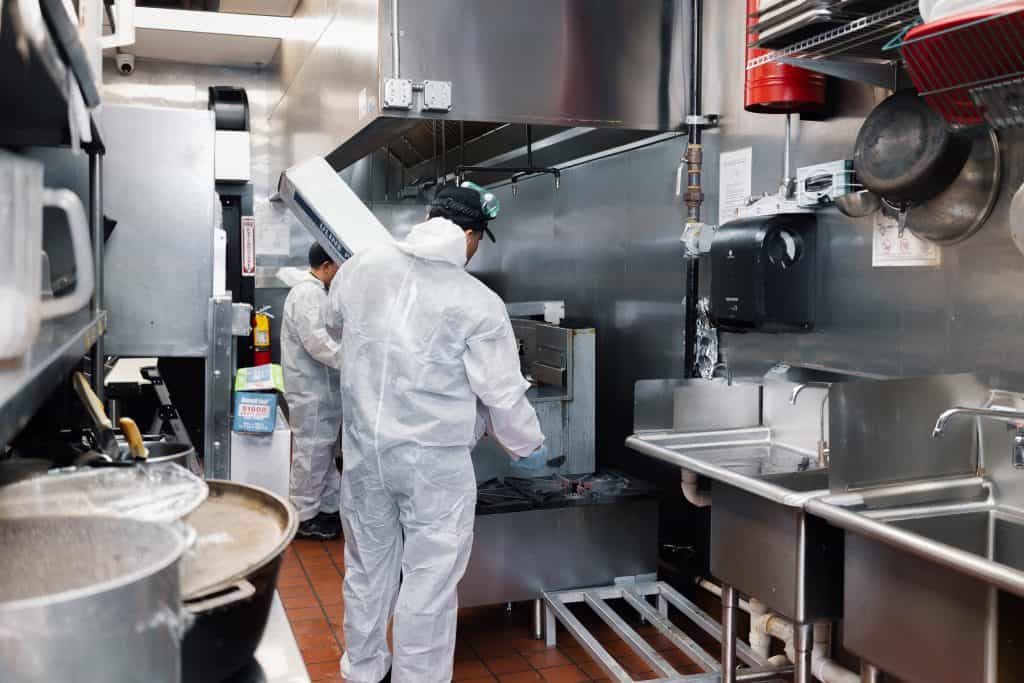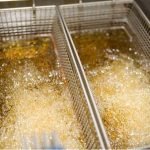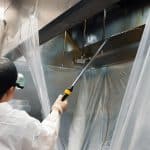Why Consistent Cleaning Costs Less Than Emergency Repairs with Commercial Cleaning Services
In the world of facility management and commercial kitchens, many businesses underestimate the true cost of neglecting regular cleaning and maintenance. What seems like “saving money” by skipping or delaying cleaning often leads to far larger expenses down the road: emergency repairs, system failures, regulatory fines, downtime, or even safety hazards.
At TruShine Services, we believe in the power of consistent, proactive maintenance—especially in hood cleaning, oil filtration, and janitorial services—to prevent those high-cost emergencies. In this post, we’ll explain why routine maintenance is more economical in the long run, using real-world examples and data, and show how your business can save money, stay compliant, and operate more reliably.

The True Cost of “Doing Nothing”
Before diving into specific service lines, it helps to understand the broader principle:
- Reactive vs. proactive: Emergency repairs often carry premium labor costs, rush parts, overtime, expedited shipping, and often more drastic system replacement rather than simple fixes.
- Downtime is expensive: When your equipment or facility is down, you lose revenue. A restaurant whose hood system fails can’t serve customers; a facility with major floor damage must shut areas off.
- Shortened equipment lifespan: Neglect accelerates wear and tear, forcing earlier replacement.
- Regulatory fines and insurance issues: For example, many fire insurance policies in the U.S. require documentation of regular hood cleaning. Without it, a claim after a fire may be denied.
Let’s look at how this plays out in your major service areas.
Hood Cleaning: Why Regular Maintenance Saves Big
Risks of neglecting hood cleaning
A commercial kitchen hood and exhaust system gathers grease, smoke particulates, and vapor over time. If not cleaned:
- Grease buildup becomes a fire hazard.
- Exhaust fan motors, ducts, and parts must work harder, increasing wear.
- Health and fire inspectors may issue fines or closures.
- Insurance claims may be denied if you can’t prove maintenance.
- Emergency duct repairs or fan replacements become necessary.
A commercial hood cleaning company refers to these as “hidden costs of neglecting hood maintenance.”
Read more here: Why Certified Hood Cleaning Protects Your Business (NFPA 96 Explained)
Typical cleaning costs vs replacement/repair costs
- Regular hood cleaning might cost $400–$600 or more depending on size, complexity, duct length, etc.
- Minor repairs on a hood (fan motor, duct patching, electrical) might run $100–$400+ depending on severity.
- Major repairs, replacements, or fire damage cleanup can go into thousands of dollars.
Thus, by investing annually or semi-annually in hood cleaning, you avoid paying for expensive repairs, lost business, or even complete replacement down the road.
Example: How routine hood cleaning pays off
Consider a restaurant with a 20-foot hood and moderate ductwork. If cleaning costs $500 twice per year, that’s $1,000 total. If skipping cleaning leads to a clogged fan motor requiring replacement at $800 plus duct repairs at $600, and closure during downtime costing $2,000 in lost sales—that’s over $3,000 in costs versus $1,000 planned.
Furthermore, a certified hood cleaning service documents its work—this protects you in fire insurance claims and inspections. NFPA 96 Fire Code for commercial kitchens
Oil Filtration: Protecting Your Cooking (or Mechanical) System
When we talk about oil filtration, this can mean filtering cooking oils (for fryers) or industrial oils (in machinery). Either way, the principle holds: clean oil = longer life and fewer failures.
Why filtration matters
- Contaminants (particles, moisture, degraded compounds) degrade oil efficacy and damage equipment under load.
- Dirty oil increases friction, leading to excess heat, wear, and failures.
- By filtering and re-conditioning oil, you reduce oil replacement costs and avoid unplanned engine or machine failures.
For restaurants, fryer oil filtration is a known cost saver: Pitco notes that the investment in oil filtration systems is quickly recouped through lower oil and maintenance costs.
Cost and ROI examples
- Suppose a fryer uses $1,000 of oil per month. If filtration can extend oil life by 30–50%, that’s a savings of $300–$500 monthly in oil costs.
- In machinery, replacing a damaged pump or motor caused by dirty oil can cost thousands. The cost of a filtration system is typically much lower.
- Some services offer on-site filtration or mobile filtration trucks, which avoids system downtime.
Hidden savings beyond oil
- Less downtime and fewer breakdowns
- Lower labor for oil changes
- Better consistency and performance
- Reduced waste disposal costs
Thus, regular oil maintenance through filtration is a proactive measure that avoids big-ticket repair or replacement costs.
Janitorial Services: More Than Just Clean Floors
Many people think janitorial or custodial services are purely cosmetic. But in reality, they play a key role in facility health, safety, asset preservation, and long-term cost control.
How janitorial services reduce long-term costs
- Extend asset life
Regular cleaning (floors, carpets, hard surfaces) prevents abrasive grit, chemicals, or debris from wearing finishes, coatings, or machinery. - Preventative maintenance
Janitors often spot leaks, cracks, developing issues early. Addressing them early prevents escalation into costly repairs. - Reduce replacement frequency
Routine care of flooring, surfaces, restroom fixtures means less frequent full replacement. Research shows a well-managed janitorial program can cut lifecycle maintenance costs by 15–25%. - Lower liability and risk
Clean, well-maintained surfaces reduce slip-and-fall incidents, which can result in lawsuits. - Optimized operations
Janitorial firms that adopt smart scheduling, waste-segmentation, and efficient supply management help clients reduce total cost of operations.
Example scenario
A facility that skips carpet cleaning might find in 3–5 years that carpet needs total replacement at $20,000. But routine care at $1,200/year helps stretch its life to 8–10 years, effectively halving the annual cost.
Also, facility cleaning vendors sometimes offer cost-cutting strategies (e.g. centralized waste bins, optimized schedules, concentrated cleaning chemicals) that reduce labor and supplies without sacrificing quality.
How TruShine Services Helps You Save — The TruShine Edge
At TruShine Services, we believe in “a dollar spent in prevention saves ten in repair.” Here’s how we deliver on that:
- Customized maintenance schedules: We assess your facility’s volume, usage, and risk, then recommend optimal frequencies (hoods quarterly, oil filtration monthly, janitorial weekly/daily).
- Certified, documented work: For hood cleaning especially, we provide inspection reports, before/after photos, and certification—valuable for insurance and compliance.
- High-efficiency, green solutions: We use high-grade, concentrated cleaning chemistries, modern filtration systems, and best practices to reduce waste and costs.
- Responsive service teams: If issues emerge, we catch them early and address them before they spiral.
- Client education: We partner with our clients, helping them understand metrics, signs of trouble, and simple practices (e.g. filter changing, spot maintenance) that preserve equipment.
By investing monthly or quarterly in TruShine’s preventive services, you’re not just buying cleaning—you’re buying security, reliability, and long-term savings.
Tips for Facility Owners: How to Get Started
- Audit your current state
- When was the last hood cleaning?
- Are fryer oils regularly filtered or changed?
- Is your janitorial team purely reactive (clean messes) or proactive?
- Cost out reactive vs proactive
Estimate what a breakdown or repair would cost (parts, labor, downtime) vs preventive cleaning. - Set a maintenance schedule
Start with hood cleaning (quarterly or semi-annually), oil filtration (monthly or per usage), and janitorial at daily/weekly schedule tailored to your facility. - Choose a qualified vendor
Look for certifications, insurance, documentation, references, modern equipment, and transparent pricing. - Track metrics
Monitor repair frequency, downtime, equipment condition, and maintenance costs before/after starting a preventive plan. - Educate your team
Train kitchen staff, operators, and building users to spot early warning signs (smoke, odors, sluggish ventilation, grime accumulation) and to report them early.
Consistent cleaning costs less than emergency repairs—especially for critical systems like kitchen hoods, oil-bearing equipment, and facility maintenance.
With TruShine Services, you’re not buying mop pushes or grease removal; you’re buying insurance against fire, system failure, fines, downtime, and expensive repairs.
Why Choose TruShine Services for Your Facility
At TruShine Services, we specialize in keeping your kitchen and facility safe, efficient, and compliant with the highest cleaning standards:
- ✔️ Exhaust Hood Systems Cleaning — fire-risk reduction & code compliance
- ✔️ Kitchen Maintenance — keep equipment running at peak performance
- ✔️ Restaurant Cleaning Programs — tailored schedules for busy kitchens
- ✔️ Grease Trap Service — prevent costly clogs & downtime
- ✔️ Cooking Oil Disposal & Filtration — eco-friendly, cost-saving solutions
📞 Call Us Today for a Free Quote
Georgia: 678-751-8871 | South Carolina: 843-502-6442 | North Carolina: 704-970-7290 | Tennessee: 423-407-5077
TruShine Services — trusted commercial cleaning services that help you save money, stay compliant, and avoid emergency repairs.




